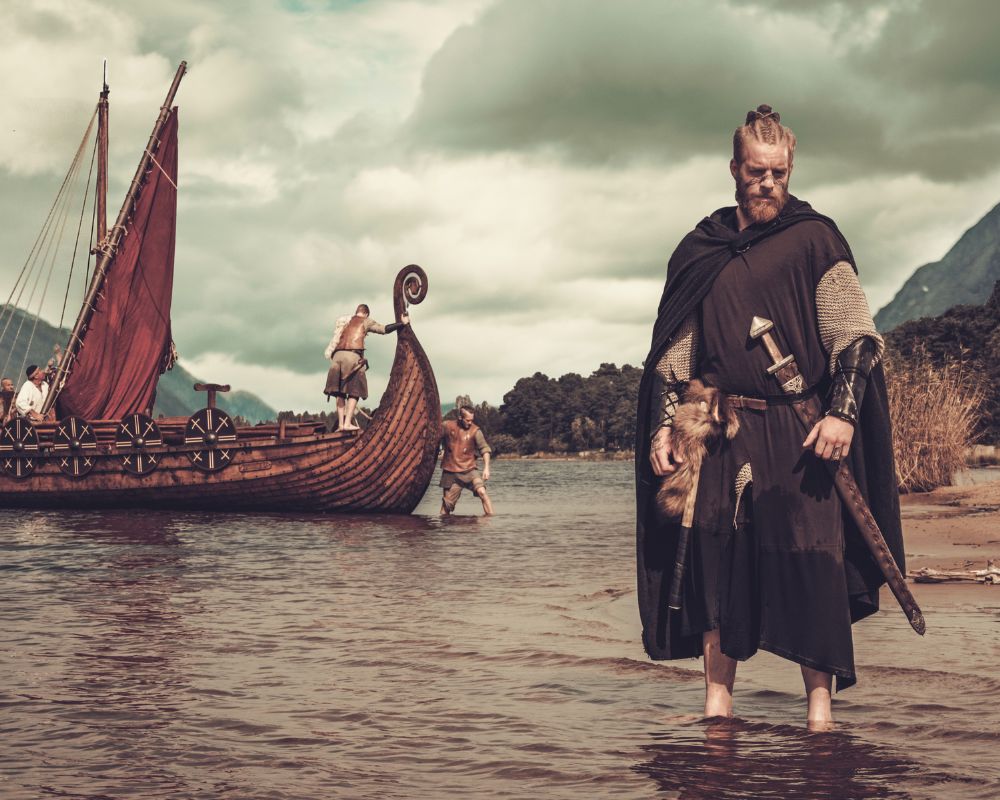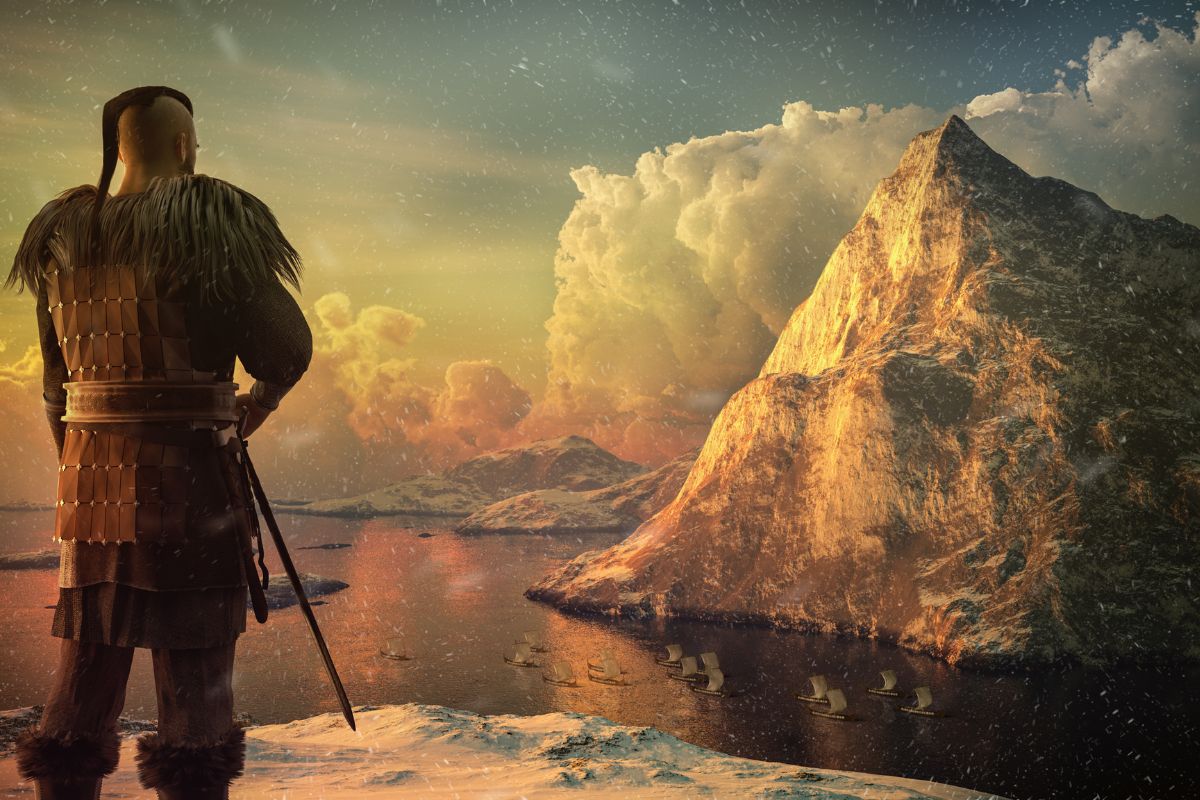A drengr was an Old Norse masculine noun meaning “a gallant or chivalrous man.” Calling a person “drengr” was the highest compliment you could pay them in the Viking age. It would mean the person had a kind of reckless courage but with a good sense of fair play.
To be a drengr was such an important feature of Norse society that the sagas constantly mentioned it, and it is often found inscribed on rune stones next to the bodies of Vikings.
Drengr Meaning And Etymology
The word “drengr” comes from the Proto-Germanic drangijaz, which means “man” or “servant” and “staff” or “stake.” It is a cognate of the Old English word “dreng” (“warrior” or “soldier”).
As well as meaning a brave or valiant man, it can also be used for one who is reckless, bold, or inexperienced and a young man.
There are several declensions, including the nominative plural “drengir.” The word is derived from the Icelandic “dregur” and the Norwegian Nynorsk “dreng” or “draing.”
The adjective is “drengiligr,” and the adverb is “drengiliga.“ Another adjective for someone showing mental resilience was “drenglyndr.” “Drengskapr” is the noun used to describe the idea of being brave and honorable.
What Was A Viking Drengr?
A drengr was a person considered to be honorable and courageous.
Viking society demanded that rulers were good examples of “drengir.” An alternative word for drengr was “skörungr.”

Could A Viking Woman Be A Drengr?
Women could be drengir.
The 13th-century Icelandic tale Njáls Saga or The Story of Burnt Njáll describes events between 960 and 1020 and includes two female drengr.
Courageous women could also be called “skörungr.”
Old Norse Examples of Drengr
The word appears on many rune stone inscriptions in the Younger Futhark alphabet along with other words to say “goðr drengr” (good drengr) or “inn bezti drengr” (the best drengr).

Þorsteins þáttr Stangarhǫggs
The Tale of Thorstein Staff-Struck or Þorsteins þáttr Stangarhǫggs tells the story of an Icelandic farmer called Þorstein who lived on his father’s (Þórarinn) farm.
Bjarni owned a neighboring farm and hired a troublesome individual called Þórðr.
On one occasion, Þorstein and Þórðr pitted their stallions against each other in a traditional Viking horse fight. Tempers frayed, and Þórðr hit Þorstein in the face with his staff.
Þorstein realized he should save face and retaliate but thought better of it and didn’t react. He asked everybody present to forget about the incident and not to tell anyone, especially his father. Þórarinn would not have taken kindly to his son, failing to show he was a drengr as other families could take advantage of the perceived weakness. Indeed, two of Bjarni’s workers, Thorvall and Thorhall, had invented the insulting name of “Staff-Struck” for Þorstein.
Þórarinn father eventually found out about the incident and mentioned it to his son. Þorstein realized that he must now confront Þórðr and ask him whether he struck him on purpose or by accident.
Þorstein and Bjarni
Þórðr tells him, “with one mouth, I can say it was an accident, and with another, I can tell you it was deliberate, but I will say no more.”
Þorstein disliked this reply and killed Þórðr. Being an honorable man, he then rode to Bjarni’s farm to tell him what had happened. As Bjarni was not at home, he told the story to a woman who was there and rode back to his father’s house.
Sometime later, Bjarni overheard the two farmhands discussing how Þorstein killed one of their colleagues without Bjarni standing up for him. Bjarni knew that he must’ve upheld his own reputation, and so had Thorvall and Thorhall go and kill Þorstein.
They tried to kill Þorstein. However, he was the better fighter, killed them both, sent them back to Bjarni, and slung over their horses.
Bjarni’s wife, Rannveig, heard about the killings and told Bjarni he couldn’t let this continue as the incidents would affect their honorable status and make them look weak.
better to have a drengr for a son than an argr
Bjarni rode over to Þorstein’s farm and challenged him to a duel. Þorstein told Bjarni he would accept “lesser outlawry,” which meant he would allow himself to be banished from Iceland for three years.
However, Bjarni told him he wanted revenge. When Þorstein went and told his father about the duel, Þórarinn told him it was better to have a drengr for a son than an argr (a coward or wretch; the opposite of drengr).
Before the duel, Þorstein asked Bjarni if he would support his elderly, blind father should he win the fight and kill him. To show he was a drengr, Bjarni readily agreed to this condition.
Bjarni and Þorstein fought for a while until Bjarni asked for a pause to have a drink of water. They fought a little longer until Bjarni asked for another break because his shield was damaged.
Þorstein’s fate
Þorstein, as a drengr, replaced Bjarni’s shield with one of his own, and they restarted the duel.
Þorstein fought well, even though Bjarni was the more powerful of the two. Bjarni then asked to pause the fight for the third time and told Þorstein that he fought with the strength of three men, and if he came to work for him, he would forgive him for killing three of his men.
Bjarni asked Þorstein if he could tell his father about the agreement, and Þorstein agreed. However, Bjarni told Þórarinn (elderly and blind) that he had killed his son. Þórarinn seemed to accept that and asked Bjarni to come closer so he could hear him better.
Bjarni saw that Þórarinn was actually going to draw his sword to kill him, so he told him the truth about Þorstein coming to work for him, and although Þórarinn questioned Bjarni’s true motives, he put his sword away.
Uses In Modern Culture
Jackson Crawford, Ph.D., an American scholar and translator, has made some interesting YouTube videos about drengr.
He says the following in his Lecture Series on Norse Myths:
“A drengr, in its original, most literal meaning, is a rock that stands alone out at sea. From this image of a rock fortress standing alone against the buffeting waves stems the meaning of drengr for human beings in Old Norse – a person with reckless courage in the face of whatever comes along.”
Crawford has also released a highly-rated translation of the Poetic Edda. It is available on Amazon or as an audiobook.
Assassin’s Creed: Valhalla
Crawford was an outside consultant on the 2020 Norse mythology video game Assassin’s Creed: Valhalla, which frequently features the concept of drengr.
The game has four difficulty levels:
- Skald (Easy)
- Vikingr (Normal)
- Berserkr (Difficult)
- Drengr (Very Difficult)
“Thor the Lost Drengr” is a character in the game. He is a fishmonger who used to fight alongside Ragnar. He wants to die honorably and challenges the main character Eivor to a duel to the death.
Star Wars Universe
In the Star Wars canon, the Drengir were huge green and brown plant-like beings with tentacles and teeth from the planet Mulita.

